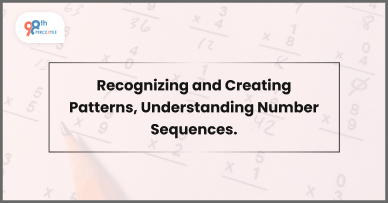Two fundamental ideas in mathematics that aid in our understanding of the outside world are patterns and number sequences. These ideas are fundamental to everything we do in our daily lives, from the patterns in nature that we see to the numerical sequences we utilize in our daily computations. We'll look at number sequence comprehension pattern recognition and creation in this blog.
What are Patterns?
An elemental arrangement that is repeated or regular is called a pattern. These elements might be any number, shape, color, or item that adheres to a particular order or set of rules. Not only is pattern recognition important in mathematics, but it's also useful in other disciplines like music, art, and even computer programming.
Example of a simple pattern
Examine the following arrangement of shapes: Square, Circle, Square, Square, Square, Circle. This design is straightforward: squares and circles alternate.
Pattern Types
-
Patterns That Repeat: These patterns have a predictable repetition. For instance, in ABABAB, A and B might stand for any number of things or symbols.
-
Growing Patterns: To make these patterns expand or contract, one element is added or withdrawn each time. For instance, in 1, 2, 3, 4, and 5, each number rises by one.
-
Patterns with Symmetry: These patterns exhibit symmetry, wherein one half is a replica of the other. Example: Radial symmetry is frequently seen in the arrangement of petals in flowers.
Start Your Child's Math Journey Now!
Creating Your Own Patterns
Making patterns is a great method to exercise your creativity and mathematical reasoning. To establish a pattern:
-
Select Your Components: Choose if you want to utilize colors, shapes, numbers, or other elements.
-
Choose the Regulation: Choose the rule that your pattern will follow. For instance, you may add 2 each time if you're making a pattern out of numbers.
-
Build the Pattern: To begin creating your pattern, start with your first piece and apply the rule several times.
Example:
Let's use the following numbers to make a pattern: 1, 2, 4, 8, 16. Each number is double the one before it. This is an instance of "multiply by 2."
Understanding Number Sequences
Number sequences are unique patterns in which the order of the numbers adheres to a predetermined rule. We may forecast the next numbers in the series and find links between numbers by comprehending these sequences.
Common Types of Number Sequences
-
Arithmetic Sequences: The difference between successive integers in an arithmetic sequence is always the same. We refer to this distinction as the "common difference."
For example, the common difference in 3, 7, 11, 15, 19, and 19 is 4.
-
Geometric Sequences: To find a term in a geometric sequence, multiply the preceding phrase by a constant known as the "common ratio."
For instance, in 2, 6, 18, and 54, the common ratio is 3.
-
Fibonacci Sequence: This well-known series begins with 0 and 1, and each number that follows is equal to the sum of the two numbers that came before it.
For instance, 0 1, 1, 2, 3, 5, 8, 13.
Applying Patterns and Sequences in Real Life
Pattern recognition and creation, as well as number sequence comprehension, are not only academic tasks. They are useful in a variety of contexts:
-
In nature: Certain patterns and sequences are followed by the spirals of a sunflower or the arrangement of leaves on a stalk.
-
In Music: In music, patterns are frequently followed by notes and rhythms to produce melody and harmony.
-
In Technology: In the field of technology, coding mostly uses patterns and sequences to create algorithms and resolve issues.
-
In Art: Patterns are used by artists to produce eye-catching designs.
Mathematics is much more than just numbers in a classroom; patterns and number sequences are essential components. You get a greater understanding of the structure and order in the world around you by learning to identify patterns, make your own, and comprehend various number sequences. These talents are useful in many areas of life, be it arithmetic problems, programming, or just taking in the scenery.
FAQs (Frequently Asked Questions)
Q.1: What is a pattern?
Ans: A pattern is a repeated or regular arrangement of elements, such as numbers, shapes, colors, or objects, following a specific rule. Patterns are found everywhere, from nature to art, and are essential in understanding and predicting sequences.
Q.2: How can I recognize a pattern?
Ans: To recognize a pattern, look for repetition or a regular sequence in the elements. Ask yourself if there's a rule that governs the arrangement, such as a consistent increase or decrease, or an alternating sequence.
Q.3: How can understanding patterns and sequences help in real life?
Ans: Understanding patterns and sequences helps in problem-solving, predicting outcomes, and organizing information. They are used in various fields, including mathematics, science, coding, music, and art.
Q.4: What is the difference between a pattern and a sequence?
Ans: A pattern is a general term that refers to any regular or repeated arrangement, while a sequence specifically refers to an ordered list of numbers or elements that follow a particular rule.
Q.5: How do I find the next number in a sequence?
Ans: To find the next number, identify the rule that the sequence follows. For example, in an arithmetic sequence, add the common difference to the last number. In a geometric sequence, multiply the last number by the common ratio.
Book 2-Week Math Trial Classes Now!
Related Articles
1. Algebra: Equations with Exponents and Simplifying Rational Equations2. Introduction to Algebraic Expressions Addition
3.
Angles: Complementary, Supplementary, Unknown Third Angle
4. Trigonometry: Unveiling the Secrets of Triangles

 Students/Staff
Students/Staff Parents
Parents ElevatEd
ElevatEd



-Nov-18-2025-03-57-47-3267-AM.png?width=360&length=360&name=401x226%20(6)-Nov-18-2025-03-57-47-3267-AM.png)



-Jul-22-2025-03-16-52-8797-AM.png?width=360&length=360&name=401x226%20(6)-Jul-22-2025-03-16-52-8797-AM.png)






